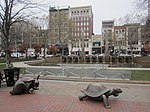1990 Back Bay, Massachusetts train collision

The 1990 Back Bay, Massachusetts train collision was a collision between an Amtrak passenger train, the Night Owl, and a Massachusetts Bay Transportation Authority (MBTA) Stoughton Line commuter train just outside Back Bay station in Boston, Massachusetts, United States. An investigation by the National Transportation Safety Board (NTSB) found that the Amtrak train entered a speed-restricted curve at excessive speed, causing the train to derail and crash into the MBTA commuter train on an adjacent track. Although no one was killed in the accident, 453 people were injured and Back Bay station was closed for six days. Total damage was estimated at $14 million. The accident led to new speed restrictions and safety improvements in the vicinity of Back Bay and a revamp of Amtrak's locomotive engineer training program.
Excerpt from the Wikipedia article 1990 Back Bay, Massachusetts train collision (License: CC BY-SA 3.0, Authors, Images).1990 Back Bay, Massachusetts train collision
Dartmouth Street, Boston South End
Geographical coordinates (GPS) Address Website Nearby Places Show on map
Geographical coordinates (GPS)
| Latitude | Longitude |
|---|---|
| N 42.3473 ° | E -71.0755 ° |
Address
Dartmouth Street 145
02116 Boston, South End
Massachusetts, United States
Open on Google Maps








